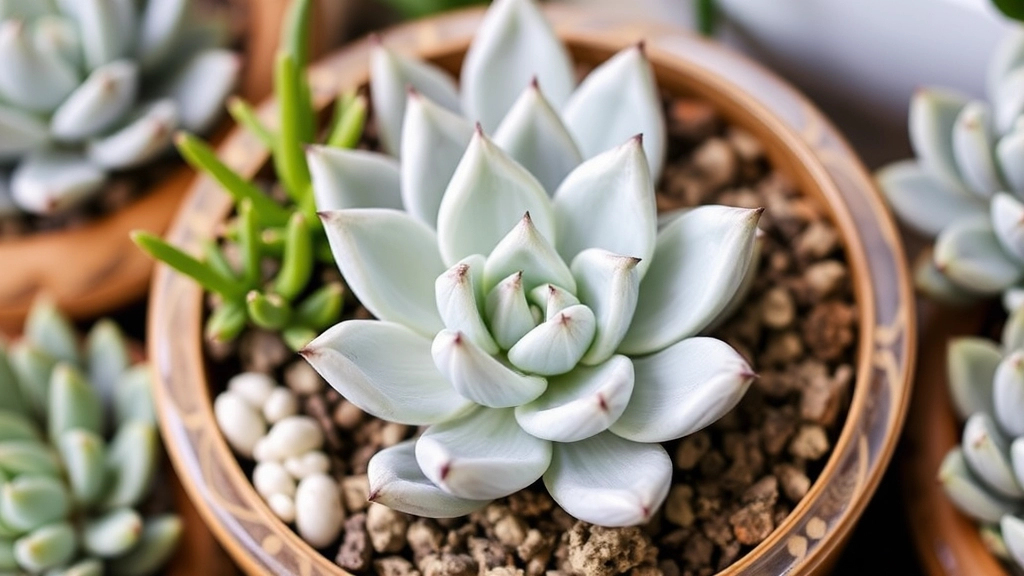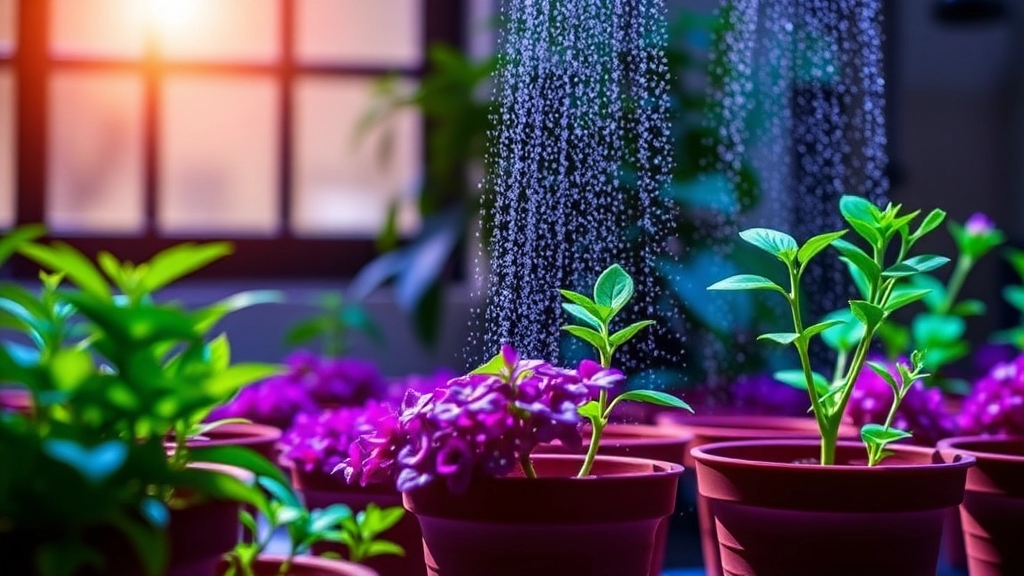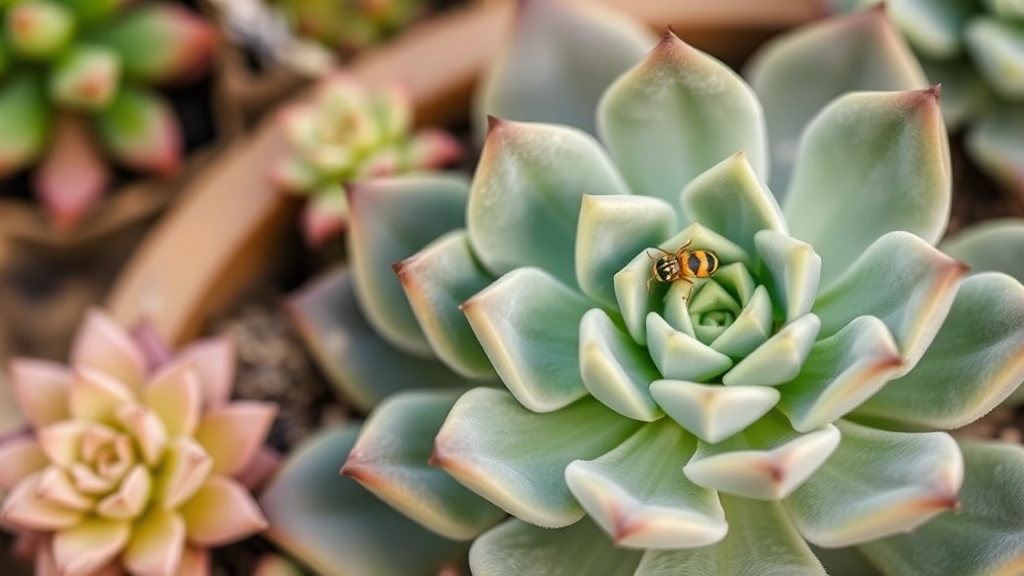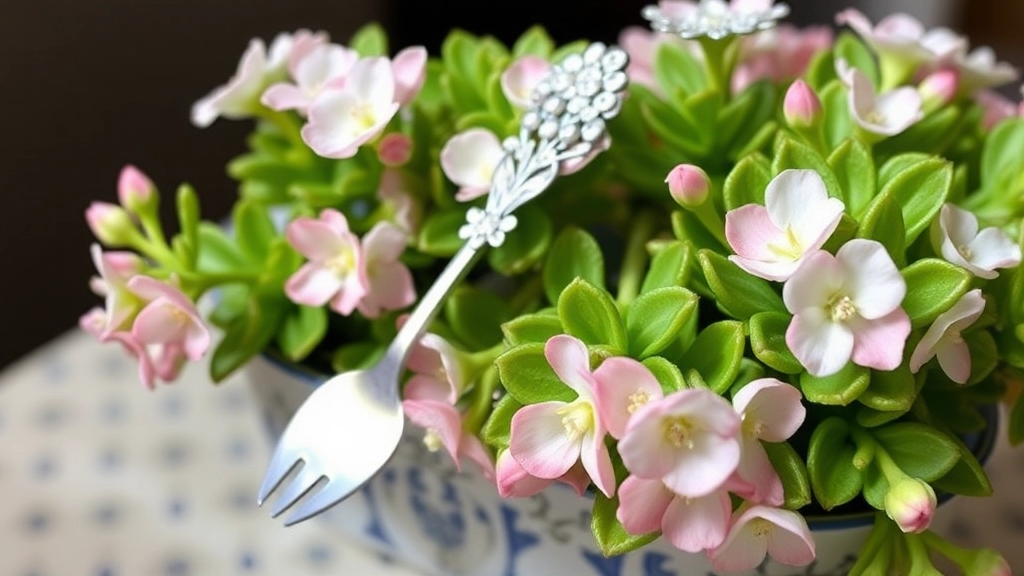Kalanchoe Silver Spoons: A Must-Have Succulent
If you’re a succulent enthusiast, Kalanchoe Silver Spoons is a must-have in your collection. Known for its striking silver, spoon-shaped leaves, this plant adds a unique touch to any garden or indoor space. In this guide, we’ll dive into the key features and ideal growing conditions for Kalanchoe Silver Spoons, ensuring you have all the tips you need for a thriving succulent.
Care Requirements
From light and watering requirements to soil and potting needs, understanding how to care for Kalanchoe Silver Spoons is essential for optimal growth. We’ll also cover propagation techniques, common pests, and seasonal care tips, helping you maintain a healthy and vibrant plant all year round.
Key Features of Kalanchoe Silver Spoons
When considering adding a unique succulent to your collection, Kalanchoe Silver Spoons often comes to mind.
This charming plant stands out for several compelling reasons.
Ideal Growing Conditions for Silver Spoons Succulents

So, you’re keen on nurturing your Kalanchoe Silver Spoons, right?
The good news is that these charming succulents are pretty adaptable, but there are some ideal conditions to keep them thriving.
Temperature and Humidity
- Temperature: Silver Spoons love warmth. Aim for temperatures between 18°C to 24°C (65°F to 75°F).
- Humidity: They prefer low humidity. If your home is too humid, these guys might struggle.
Light Requirements
- Bright, Indirect Light: Place them where they can soak up bright, indirect sunlight. Too much direct sun can scorch those lovely leaves.
- Indoor Lighting: A south or west-facing window is usually perfect.
Watering Needs
- Drench and Dry: Water them thoroughly, then let the soil dry out completely before the next watering.
- Frequency: Generally, watering every two to three weeks works well, but adjust based on your climate.
Soil Type
- Well-Draining Soil: Use a cactus or succulent mix. You want that water to flow through, not sit around the roots.
Potting
- Terracotta Pots: They’re ideal as they allow moisture to escape. Plus, they look great!
How to Propagate Kalanchoe Silver Spoons
Many enthusiasts often wonder how to expand their collection of Kalanchoe Silver Spoons without spending a fortune. Propagation is an excellent way to achieve this, and it’s simpler than you might think.
Light and Watering Requirements for Optimal Growth

When caring for Kalanchoe Silver Spoons, understanding light and watering needs is crucial for ensuring vibrant growth. Many succulent enthusiasts often wonder, “How much light does my Kalanchoe need?” or “Am I overwatering my plant?” These concerns are common, and addressing them can lead to a thriving succulent.
Light Requirements
Kalanchoe Silver Spoons thrives in bright, indirect sunlight. Here’s what you should keep in mind:
- Direct Sunlight: While some morning sun is beneficial, avoid harsh afternoon rays that can scorch the leaves.
- Indoor Placement: A south or west-facing window is ideal. If the leaves start to stretch, your plant may not be getting enough light.
- Outdoor Conditions: If placed outside, ensure it’s in partial shade during the hottest parts of the day.
Watering Needs
Watering can be tricky, but here are some straightforward guidelines:
- Soil Check: Always check the top inch of the soil. If it’s dry, it’s time to water.
- Frequency: Typically, watering every two to three weeks works well, but this may vary depending on your environment.
- Drainage: Ensure your pot has drainage holes to prevent root rot. Succulents prefer to be on the drier side.
Summary
In summary, Kalanchoe Silver Spoons requires bright, indirect light and a careful watering routine. By monitoring these conditions, you can promote optimal growth and health for your succulent.
Choosing the right soil and potting conditions is crucial for the health of your Kalanchoe Silver Spoons.
Many plant enthusiasts worry about the best mix to use for their succulents.
Kalanchoe Bracteata thrives in well-draining soil. Here are some key points to consider:
– **Cactus or Succulent Mix**: A pre-made cactus mix is often ideal, as it allows for proper drainage.
– **DIY Mix**: If you prefer making your own, combine:
– 50% potting soil
– 25% perlite
– 25% coarse sand
This mix ensures that excess moisture drains away, preventing root rot.
When potting your Kalanchoe Silver Spoons, keep the following in mind:
– **Pot Size**: Choose a pot that is slightly larger than the root ball. This gives the plant room to grow without excess soil that retains moisture.
– **Drainage Holes**: Ensure your pot has adequate drainage holes. This is essential to prevent water accumulation.
– **Material**: Terracotta pots are a great choice as they absorb moisture, helping to keep the soil dry.
Repotting your Kalanchoe Bracteata every couple of years can refresh the soil and promote growth. Here’s how:
– **Timing**: Late spring is the best time to repot.
– **Gently Remove**: Carefully take the plant out of its current pot, shaking off excess soil.
– **Check Roots**: Inspect the roots for any signs of rot or damage and trim if necessary.
For more detailed guidance on Kalanchoe care, you might find the [complete care guide for Kalanchoe Flapjack Plant](https://planthq.org/complete-care-guide-for-kalanchoe-flapjack-plant/) helpful. Additionally, if you’re dealing with issues like drooping leaves, check out [how to fix drooping Kalanchoe leaves](https://planthq.org/how-to-fix-drooping-kalanchoe-leaves-causes-and-solutions/).
Common Pests and How to Protect Your Succulent

So, you’ve got your Kalanchoe Silver Spoons looking all cute and plump, but what if I told you those little beauties can attract some unwanted guests?
Common Pests to Watch For:
- Mealybugs: These fluffy little pests love to hide in the crevices of your plant. They suck the sap, which can weaken your succulent.
- Aphids: Tiny and often green, these guys can multiply quickly. They also feast on the plant’s sap and can lead to other issues.
- Spider Mites: If you notice fine webbing on your plant, it’s likely spider mites. They thrive in dry conditions and can cause leaf drop.
- Scale Insects: These look like small bumps on the leaves. They can be tricky to spot but can lead to yellowing leaves.
How to Protect Your Kalanchoe Silver Spoons:
- Regular Inspections: Check your plant weekly. Catching pests early makes all the difference.
- Neem Oil: A natural pesticide that works wonders. Just mix it with water and spray your plant.
- Soap Solution: A mix of water and mild soap can help. Spray it on the infested areas to suffocate the pests.
- Isolate Affected Plants: If you find pests, move the affected plant away from your other succulents to prevent spreading.
- Maintain Humidity: Spider mites love dry air. Keeping your home slightly humid can deter them.
- Healthy Plants are Happy Plants: Ensure your Kalanchoe is well-fed and watered. A strong plant is less likely to attract pests.
As we delve deeper into the care of Kalanchoe Silver Spoons, it’s essential to consider how seasonal changes can impact your succulent’s health and growth. Understanding these shifts will help you provide the best care throughout the year.
### Spring
– **Repotting**: This is the ideal time to repot your Kalanchoe Silver Spoons if you notice it outgrowing its pot. Choose a slightly larger pot with good drainage.
– **Fertilising**: Start fertilising with a balanced succulent fertiliser to encourage new growth. A diluted solution every four to six weeks works wonders.
– **Watering**: As temperatures rise, increase watering frequency, ensuring the soil dries out completely between waterings.
### Summer
– **Light Exposure**: Ensure your succulent receives plenty of bright, indirect sunlight. Too much direct sun can scorch the leaves.
– **Humidity Control**: If you’re in a particularly humid area, ensure good air circulation around your plants to prevent rot.
– **Pest Monitoring**: Keep an eye out for pests like mealybugs and spider mites, which can thrive in warm weather.
### Autumn
– **Watering Adjustment**: As temperatures begin to drop, reduce watering frequency. Your plant will require less moisture as it enters dormancy.
– **Temperature Awareness**: Protect your Kalanchoe from sudden temperature drops. Ideally, keep it in a location where temperatures stay above 10°C (50°F).
– **Pruning**: Remove any dead or yellowing leaves to promote air circulation and prevent disease.
### Winter
– **Light Needs**: Ensure your plant still receives adequate light during the shorter days. A south-facing window can be ideal.
– **Watering**: Water sparingly during winter months. Check the soil moisture to avoid overwatering, which can lead to root rot.
– **Protection from Cold**: If your succulent is outdoors, consider bringing it inside during frost. Kalanchoe Silver Spoons can be sensitive to cold temperatures. For more detailed advice, you might want to check out [winter care tips for healthy Kalanchoe plants](https://planthq.org/winter-care-tips-for-healthy-kalanchoe-plants/).
For those interested in a broader understanding of Kalanchoe care, our [ultimate guide to growing and caring for succulent plant Kalanchoe](https://planthq.org/ultimate-guide-to-growing-and-caring-for-succulent-plant-kalanchoe/) offers extensive insights.
Indoor vs Outdoor Care for Kalanchoe Silver Spoons

So, you’ve got your Kalanchoe Silver Spoons, and now you’re wondering where it’ll thrive best—indoors or out?
Indoor Care:
- Light: Place it near a bright window, but avoid direct harsh sunlight. It loves bright, indirect light.
- Temperature: Keep it in a warm spot, ideally between 20-25°C. Watch out for chilly drafts!
- Watering: Less is more! Water when the top inch of soil feels dry. Overwatering is a common pitfall.
- Humidity: Kalanchoe Silver Spoons prefer dry air, so they’re perfect for indoor environments.
Outdoor Care:
- Sunlight: They love basking in full sun, but a little shade during the hottest part of the day can be beneficial.
- Temperature: They can handle warmer temperatures but be cautious of frost. Protect them if it gets too cold.
- Watering: Outdoor plants may need more frequent watering, especially in hot weather. Just ensure the soil drains well.
- Soil: A gritty, well-draining mix is essential outdoors to prevent root rot.
Key Differences:
- Light Needs: Indoor plants require indirect sunlight, while outdoor ones can soak up the sun.
- Watering Frequency: Indoor plants need less water, while outdoor ones may need a bit more, depending on the weather.
- Temperature Sensitivity: Indoor plants are generally more protected from temperature extremes.
Troubleshooting Common Issues with Kalanchoe Silver Spoons
As we delve deeper into the care of Kalanchoe Silver Spoons, it’s crucial to address some common issues that may arise. Understanding how to troubleshoot these problems can help ensure your succulent thrives.
1. Leaf Dropping
If you notice leaves falling off your Kalanchoe Silver Spoons, it could be due to several factors:
- Overwatering: The most common culprit. Ensure the soil dries out between waterings.
- Underwatering: Conversely, if the leaves are shrivelling, your plant might be thirsty.
- Temperature Stress: Sudden temperature changes can shock the plant. Keep it in a stable environment.
2. Fading Colour or Stretching
A loss of vibrant colour or elongated growth can signal insufficient light.
- Solution: Move your plant to a brighter spot, ideally with indirect sunlight.
- Tip: If you notice the plant leaning towards the light, it’s a sign it needs more exposure.
3. Pest Infestation
Pests such as mealybugs or aphids can invade your Kalanchoe Silver Spoons.
- Signs: Look for sticky residue or webbing on the leaves.
- Treatment: Use insecticidal soap or neem oil to eliminate these pests. Regularly inspect your plant to catch infestations early.
4. Root Rot
This issue is often a result of overwatering.
- Symptoms: Yellowing leaves and a mushy stem are telltale signs.
- Solution: If you suspect root rot, remove the plant from its pot, trim away affected roots, and repot in fresh, dry soil. For more detailed steps, check out our Kalanchoe Mother of Thousands Care and Propagation Guide.
5. Wilting Leaves
Wilting can be a sign of both overwatering and underwatering.
- Action: Assess the soil moisture. If it’s soggy, let it dry out. If it’s dry, give your plant a good drink. For more tips, visit our Bountiful Kalanchoe Care: Expert Tips for Thriving Plants.
FAQs About Kalanchoe Silver Spoons
What are the ideal growing conditions for Kalanchoe Silver Spoons?
The ideal growing conditions for Kalanchoe Silver Spoons include warm temperatures between 18°C to 24°C (65°F to 75°F), low humidity, and bright, indirect sunlight. They also thrive in well-draining soil and terracotta pots.
How much light does Kalanchoe Silver Spoons need?
Kalanchoe Silver Spoons requires bright, indirect light. While some morning sun is beneficial, avoid harsh afternoon rays that can scorch the leaves. A south or west-facing window is ideal for indoor placement.
How often should I water my Kalanchoe Silver Spoons?
Water your Kalanchoe Silver Spoons thoroughly, then let the soil dry out completely before the next watering. Typically, watering every two to three weeks works well, but you should adjust based on your climate and environment.
What type of soil is best for Kalanchoe Silver Spoons?
Use a well-draining soil mix, such as a cactus or succulent mix. This ensures that water flows through and does not sit around the roots, which can cause root rot.
What pests should I watch out for with my Kalanchoe Silver Spoons?
Common pests include mealybugs, aphids, spider mites, and scale insects. Regular inspections, neem oil, soap solutions, and maintaining proper humidity can help protect your plant from these pests.
Can Kalanchoe Silver Spoons be grown indoors and outdoors?
Yes, Kalanchoe Silver Spoons can be grown both indoors and outdoors. Indoor plants need bright, indirect light and less frequent watering, while outdoor plants can handle full sun but may require more frequent watering and protection from frost.
How can I tell if my Kalanchoe Silver Spoons is getting enough light?
If the leaves start to stretch, your plant may not be getting enough light. Ensure it is placed in a location with bright, indirect sunlight. For outdoor plants, partial shade during the hottest parts of the day is beneficial.
What should I do if my Kalanchoe Silver Spoons gets pests?
If you find pests, isolate the affected plant to prevent spreading. Use neem oil or a soap solution to treat the pests, and check your plant weekly to catch any infestations early.
What are the key differences between indoor and outdoor care for Kalanchoe Silver Spoons?
Indoor plants require indirect sunlight and less frequent watering, while outdoor plants can soak up more sun and may need more frequent watering depending on the weather. Indoor plants are generally more protected from temperature extremes.
References
-
The Spruce: Kalanchoe Silver Spoons Care
-
World of Succulents: Kalanchoe bracteata ‘Silver Spoons’
-
Succulent City: Kalanchoe Silver Spoons Care Guide
